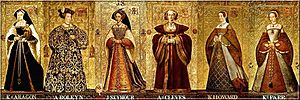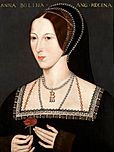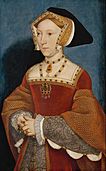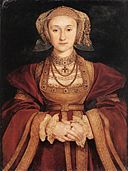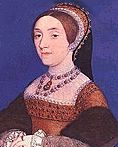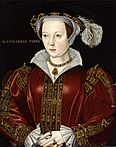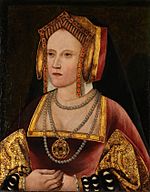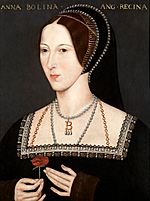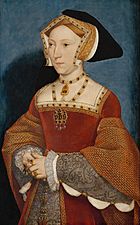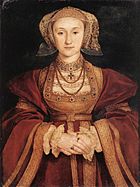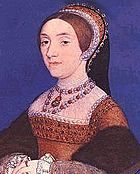Wives of Henry VIII facts for kids
(years of marriage)
"Divorced, beheaded, died
Divorced, beheaded, survived"
(1509–1533)
(1533–1536)
(1536–1537)
(1540)
(1540–1542)
(1543–1547)
In common parlance, the wives of Henry VIII were the six queen consorts of King Henry VIII of England between 1509 and his death in 1547. In legal terms, Henry had only three wives, because three of his marriages were annulled by the Church of England. However, he was never granted an annulment by the Pope, as he desired, for Catherine of Aragon, his first wife. Annulments declare that a true marriage never took place, unlike a divorce, in which a married couple end their union. Along with his six wives, Henry took several mistresses.
Contents
Overview
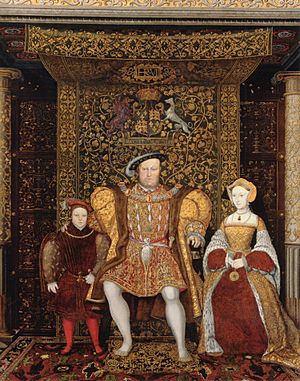
The six women who were married to Henry VIII, in chronological order:
| No. | Name | Marriage dates and length | Fate of marriage | Issue and fate |
|---|---|---|---|---|
| 1 | Catherine of Aragon | 11 June 1509 – 23 May 1533 (23 years, 11 months and 12 days) |
Annulled | Died 7 January 1536. Mother of Queen Mary I. |
| 2 | Anne Boleyn | 28 May 1533 – 17 May 1536 (2 years, 11 months and 19 days) |
Annulled (2 days prior to execution) | Beheaded 19 May 1536 at the Tower of London. Mother of Queen Elizabeth I. |
| 3 | Jane Seymour | 30 May 1536 – 24 October 1537 (1 year, 4 months and 24 days) |
Ended with Seymour's death | Died 24 October 1537, due to complications twelve days after giving birth. Mother of King Edward VI. |
| 4 | Anne of Cleves | 6 January 1540 – 12 July 1540 (6 months and 6 days) |
Annulled | Died 16 July 1557. |
| 5 | Catherine Howard | 28 July 1540 – 13 February 1542 (1 year, 6 months and 16 days) |
Ended with Howard's beheading | Beheaded 13 February 1542 at the Tower of London. |
| 6 | Catherine Parr | 12 July 1543 – 28 January 1547 (3 years, 6 months and 16 days) |
Ended with Henry's death | Survived Henry VIII, remarried to Thomas Seymour (brother of Jane Seymour, third wife of Henry VIII) Died 5 September 1548. |
Henry's first marriage to Catherine of Aragon lasted nearly 24 years, while the following five lasted less than 10 years combined.
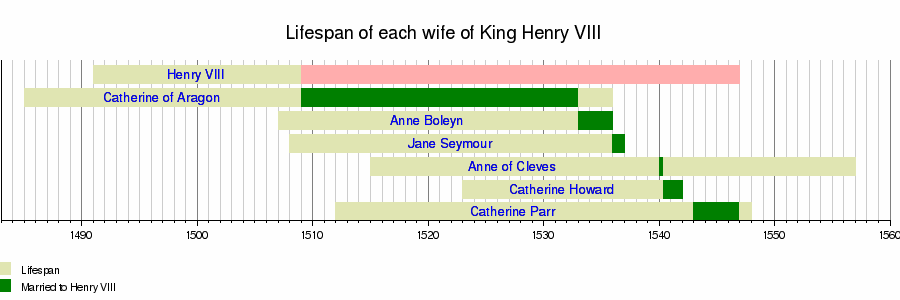
English historian and House of Tudor expert David Starkey describes Henry VIII as a husband:
What is extraordinary is that in the beginning of Henry's marriages, he was usually a very good husband. He was very tender to them, research shows that he addressed some of his wives as "sweetheart." He was a good lover, he was very generous: the wives were given huge settlements of land and jewels. He was immensely considerate when they were pregnant. However, if his current wife did not please him or did anything to fire his short temper, there would be consequences. Two of Henry's wives were beheaded by his command.
Descendants and relationships
Catherine of Aragon, Anne Boleyn, and Jane Seymour each gave Henry VIII one child who survived infancy: two daughters and one son, respectively. All three of these children eventually ascended to the throne as King Edward VI, Queen Mary I, and Queen Elizabeth I.
Anne Boleyn and Catherine Howard were first cousins. Jane Seymour was second cousin to both Anne Boleyn and Catherine Howard. Several of Henry's wives worked in service to another wife, typically as a lady-in-waiting. Anne Boleyn served Catherine of Aragon. Jane Seymour served both of her predecessors, Catherine of Aragon and Anne Boleyn. Catherine Howard served Anne of Cleves.
Catherine of Aragon
Catherine of Aragon (16 December 1485 – 7 January 1536; Spanish: Catalina de Aragón) was Henry's first wife. In modern sources, her name is most commonly spelled Catherine, although she spelled and signed her name with a "K," which was an accepted spelling in England at the time.
Catherine was originally married to Arthur, Henry's older brother. Catherine was a year older than Arthur and six years older than Henry. After Arthur died in 1502, a papal dispensation was obtained to enable her to marry Henry, though the marriage did not occur until he came to the throne in 1509, when Henry was 18 years old and Catherine was 24. Catherine became pregnant in 1510, but the girl was stillborn. She became pregnant again in 1511 and gave birth to Henry, Duke of Cornwall, who died almost two months later. She gave birth to a stillborn boy in 1513, and to another boy who died within hours in 1515. Finally, at age 31, she bore a healthy daughter, Mary, in 1516. After giving birth to Mary, Catherine is quoted to say, "We are both young. If it was a daughter this time, by the Grace of God the sons will follow". Unfortunately, she never did have that son Henry so desperately wanted. It was two years before she conceived again; the pregnancy ended with a short-lived girl.
It is said that Henry truly loved Catherine of Aragon, as he professed it many times. However, Henry became concerned he did not have a son to continue the Tudor dynasty.
Henry, at the time a Roman Catholic, sought the Pope's approval for an annulment on the grounds that Catherine had first been his brother's wife. Despite the Pope's refusal to annul the marriage, Henry separated from Catherine in 1531; Catherine was 46, Henry was 40. He ordered the highest church official in England, Thomas Cranmer, Archbishop of Canterbury, to convene a court. On 23 May 1533, Cranmer ruled the marriage to Catherine null and void. On 28 May 1533, he pronounced the King legally married to Anne Boleyn (with whom Henry had already secretly exchanged wedding vows). This led to England breaking from the Roman Catholic Church and the establishment of the Church of England.
Shortly after marrying Anne Boleyn, Henry sent Catherine away. She did not see Henry, or their daughter Mary, again before her death in isolation at age 51.
William Shakespeare, in the play Henry VIII, called Catherine "The queen of earthly queens" (2.4.138).
Anne Boleyn
Anne Boleyn (c. 1507 – 19 May 1536) was Henry's second wife and the mother of Elizabeth I. Henry's marriage to Anne and her execution made her a key figure in the political and religious upheaval at the start of the English Reformation. She was the daughter of Sir Thomas Boleyn and Lady Elizabeth Boleyn (born Lady Elizabeth Howard), and she was of nobler birth than Jane Seymour, Henry's later wife. She was dark-haired with beautiful features and lively manners; she was educated in Europe. She studied French and lived there for part of her life. She was largely as a lady-in-waiting to Queen Claude of France.
In 1533, Henry and Anne went through a secret wedding service. Henry was 42, and Anne was in her late 20s. She soon became pregnant and there was a second, public wedding service in London on 25 January 1533. On 23 May 1533, Cranmer declared the marriage of Henry and Catherine null and void. Five days later, Cranmer declared the marriage of Henry and Anne to be good and valid. Soon after, the Pope launched sentences of ex-communication against the King and the Archbishop. As a result of Anne's marriage to the King, the Church of England was forced to break with Rome and was brought under the king's control. Anne was crowned Queen Consort of England on 1 June 1533, and she gave birth to Henry's second daughter Elizabeth on 7 September. She failed to produce a male heir, her only son being stillborn. Henry grew tired of Anne and waiting for a son that she could not produce. Henry had their marriage annulled. Henry looked around for another mistress while Thomas Cromwell devised a plot to execute her.
Despite unconvincing evidence, she was found guilty of engaging in relations with her brother, George Boleyn, and Anne, no older than 31 years old, was beheaded on 19 May 1536. After the coronation of her daughter, Elizabeth I, Anne was venerated as a martyr and heroine of the English Reformation, particularly due to the works of John Foxe. Over the centuries, she has inspired or been mentioned in numerous artistic and cultural works.
Jane Seymour
Jane Seymour (c. 1508 – 24 October 1537) was Henry's third wife. She served Catherine of Aragon as maid-of-honour and was one of Anne Boleyn's ladies-in-waiting.
Jane, the daughter of Sir John Seymour, a knight, and Margery Wentworth, was most likely born at Wulfhall, Wiltshire, although West Bower Manor in Somerset has also been suggested. Her birth date is not recorded although rumored. She was of lower birth than most of Henry's wives, only being able to read and write a little, but was much better at needlework and household management, which were considered much more necessary for the time.
Jane married Henry VIII on 20 May 1536, at the Palace of Whitehall, Whitehall, London, the day after Anne Boleyn's execution. Jane was 28, Henry was 45. Almost a year and a half after marriage, Jane gave birth to a male heir, Edward, but she died twelve days later from postpartum complications. Jane was the only wife to receive a proper queen's burial. When Henry died, he chose to be buried next to her in St George's Chapel, Windsor Castle. It is unclear if this decision was purely sentimental or a political signal designed to reinforce the legitimacy of his youthful heir, Edward VI.
Anne of Cleves
Anne of Cleves (28 June or 22 September 1515 – 16 July 1557) was a German princess, Henry's fourth wife and queen consort of England, although not crowned, for just six months in 1540, from 6 January to 12 July. Henry may have referred to her as "A Flanders mare", and the label has stuck.
Anne of Cleves' portrait was painted by Hans Holbein and sent to King Henry to evaluate to be his future wife. Her brother didn't allow Holbein to paint whilst looking directly at Anne and her little sister's faces so they had to wear veils whilst being painted. Henry fell in love with her portrait and wanted her sent to him. When she arrived, Henry was not impressed. Henry complained of her not looking like her portrait. Her pre-contract of marriage with Francis I, Duke of Lorraine, was cited as grounds for annulment, even though their marriage did not proceed. Anne did not resist the annulment and was rewarded with a generous settlement including Hever Castle, the former home of the Boleyns, Henry's former in-laws. She was given the name "The King's Sister" and was a lifelong friend to him and his children; Anne of Cleves was approximately the same age as Henry VIII's eldest surviving daughter, Mary. She outlived the King and all his wives, dying at Chelsea Old Manor on 16 July 1557; the most likely cause of her death was cancer. She was buried in Westminster Abbey on 3 August.
Catherine Howard
Catherine Howard (c. 1521 – 13 February 1542), also spelled Katheryn, was Henry's fifth wife, between 1540 and 1542. She was the daughter of Lord Edmund Howard and Joyce Culpeper, cousin to Anne Boleyn (the second wife of Henry VIII), second cousin to Jane Seymour (the third wife of Henry VIII), and niece to Thomas Howard, 3rd Duke of Norfolk. She was raised in the household of her step-grandmother Agnes Tilney, the Dowager Duchess of Norfolk. Her uncle Thomas Howard was a prominent politician at Henry's court, and he secured her a place in the household of Henry's fourth wife, Anne of Cleves, where Catherine caught the King's interest. She married him on 28 July 1540 at Oatlands Palace in Surrey, just 19 days after the annulment of his marriage to Anne. He was 49, and she was still a teenager, likely around 18. (Catherine Howard was younger than Henry VIII's oldest child, Mary I, who was 24 years old when he married his fifth wife; Elizabeth was 9, and Edward was 3.)
On 1 November 1541, Henry was informed of her alleged infidelity. Catherine was stripped of her title as queen in November 1541 and was beheaded in February 1542.
Catherine Parr
Catherine Parr (1512 – 5 September 1548), also spelled Kateryn, was the sixth and last wife of Henry VIII, 1543–1547. She was the daughter of Sir Thomas Parr of Kendal and his wife, Maud Green. Through her father, Catherine was a descendant of John of Gaunt, son of King Edward III. Through John of Gaunt's daughter Joan Beaufort, Countess of Westmoreland (Henry's great-great-grandmother), she was Henry's third cousin, once removed. By Henry's paternal descent from another of John of Gaunt's children, John Beaufort, 1st Earl of Somerset, the two were also fourth cousins once removed.
Catherine showed herself to be the restorer of Henry's court as a family home for his children. She was determined to present the royal household as a close-knit one to demonstrate strength through unity to Henry's opposition. Perhaps Catherine's most significant achievement was Henry's passing of an act that confirmed both Mary's and Elizabeth's line in succession for the throne, despite the fact that they had both been made illegitimate by divorce or remarriage. At the time of the passage of the act, Catherine Parr was 31, Mary was 27, Elizabeth was 10, and Henry was 52. Such was Henry's trust in Catherine that he chose her to rule as Regent while he was attending to the war in France, and in the unlikely event of the loss of his life, she was to serve as Regent until nine-year-old Edward came of age.
Catherine also has a special place in history, as she was the most married queen of England, having had four husbands in all; Henry was her third. She had been widowed twice before marrying Henry. After Henry's death, she married Thomas Seymour, uncle of Edward VI of England, to whom she had formed an attachment before her marriage with Henry. She had one child by Seymour, Mary, and died shortly after childbirth, at age 35 or 36. Lady Mary's history is unknown, but she is not believed to have survived childhood. She is buried at Sudeley Castle in the town of Winchcombe.
See also
 In Spanish: Esposas de Enrique VIII para niños
In Spanish: Esposas de Enrique VIII para niños


